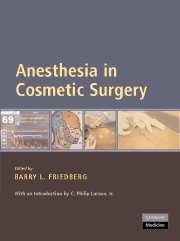Book contents
- Frontmatter
- Contents
- Foreword
- Acknowledgments
- Introduction
- Preface
- List of Contributors
- PART I MINIMALLY INVASIVE ANESTHESIA (MIA)Ⓡ FOR MINIMALLY INVASIVE SURGERY
- PART II ALTERNATIVE ANESTHESIA APPROACHES IN COSMETIC SURGERY
- 11 Intravenous Anesthesia for Cosmetic Surgery
- 12 Regional Anesthesia for Cosmetic Surgery
- 13 General Inhalation Anesthesia for Cosmetic Surgery
- PART III OTHER CONSIDERATIONS FOR ANESTHESIA IN COSMETIC SURGERY
- APPENDIX A A Guide to Perioperative Nutrition
- APPENDIX B Reflections on Thirty Years as an Expert Witness
- Index
- References
11 - Intravenous Anesthesia for Cosmetic Surgery
from PART II - ALTERNATIVE ANESTHESIA APPROACHES IN COSMETIC SURGERY
Published online by Cambridge University Press: 22 August 2009
- Frontmatter
- Contents
- Foreword
- Acknowledgments
- Introduction
- Preface
- List of Contributors
- PART I MINIMALLY INVASIVE ANESTHESIA (MIA)Ⓡ FOR MINIMALLY INVASIVE SURGERY
- PART II ALTERNATIVE ANESTHESIA APPROACHES IN COSMETIC SURGERY
- 11 Intravenous Anesthesia for Cosmetic Surgery
- 12 Regional Anesthesia for Cosmetic Surgery
- 13 General Inhalation Anesthesia for Cosmetic Surgery
- PART III OTHER CONSIDERATIONS FOR ANESTHESIA IN COSMETIC SURGERY
- APPENDIX A A Guide to Perioperative Nutrition
- APPENDIX B Reflections on Thirty Years as an Expert Witness
- Index
- References
Summary
INTRODUCTION
In the 1840s came the first case reports of successfully anesthetizing patients for surgical procedures. The agents used were inhalational agents, specifically diethyl ether and nitrous oxide. Crawford Long, Horace Wells, and William T. G. Morton will forever be credited with bringing the benefits of anesthesia to patients undergoing surgery. No longer would surgical patients needlessly suffer. In this era, the only ways to deliver an anesthetic systemically was by inhalation or ingestion (hollow needles had not yet been invented). Inhalation agents provided a rapid, reliable, predictable way to anesthetize patients compared with ingesting alcohol and/or opiates. Hollow needles were introduced in the late 1800s.
Although various injectable adjuncts such as opiates, sedative/hypnotics, dissociative agents, and muscle relaxants were developed in the early and mid 20th century, inhalation agents (i.e., nitrous oxide and the halogenated ether derivatives such as halothane, ethrane, isoflurane) were the mainstays of anesthesia until the 1980s. However, they were far from ideal. Inhalation agents (volatile) are fraught with a myriad of side effects, such as myocardial depression, hypotension, arrhythmias, and postoperative nausea and vomiting (PONV). Anesthesia was very risky until the 1980s. The combination of cardiovascular effects of inhalation agents, the routine use of muscle relaxants, and lack of sophisticated monitoring devices other than ECG, NIABP, and spirometry (in addition to the finger on the pulse, stethoscope, and direct observation) was the underlying reason. Anesthetic-related death rates were generally quoted in the 1-in-10,000 range.
- Type
- Chapter
- Information
- Anesthesia in Cosmetic Surgery , pp. 112 - 130Publisher: Cambridge University PressPrint publication year: 2007



